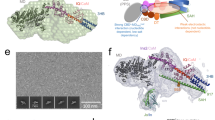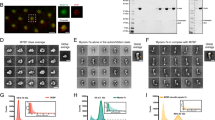Abstract
The F-actin based motor protein myosin II has a key role in cytokinesis. Here we show that the Schizosaccharomyces pombe regulatory light chain (RLC) protein Rlc1p binds to Myo2p in manner that is dependent on the IQ sequence motif (the RLC-binding site), and that Rlc1p is a component of the actomyosin ring. Rlc1p is important for cytokinesis at all growth temperatures and is essential for this process at lower temperatures. Interestingly, all deleterious phenotypes associated with the loss of Rlc1p function are suppressed by deletion of the RLC binding site on Myo2p. We conclude that the sole essential function of RLCs in fission yeast is to relieve the auto-inhibition of myosin II function, which is mediated by the RLC-binding site, on the myosin heavy chain (MHC).
This is a preview of subscription content, access via your institution
Access options
Subscribe to this journal
Receive 12 print issues and online access
$209.00 per year
only $17.42 per issue
Buy this article
- Purchase on Springer Link
- Instant access to full article PDF
Prices may be subject to local taxes which are calculated during checkout



Similar content being viewed by others
References
Satterwhite, L. L. & Pollard, T. D. Curr. Opin. Cell Biol. 4, 43–52 (1992).
Harrington, W. F. & Rodgers, M. E. Annu. Rev. Biochem. 53, 35–73 (1984).
Karess, R. E. et al. Cell 65, 1177–1189 (1991).
Chen, P., Ostrow, B. D., Tafuri, S. R. & Chisholm, R. L. J. Cell Biol. 127, 1933–1944 (1994).
Uyeda, T. Q. & Spudich, J. A. Science 262, 1867–1870 (1993).
Kitayama, C., Sugimoto, A. & Yamamoto, M. J. Cell Biol. 137, 1309–1319 (1997).
May, K. M., Win, T. Z. & Hyams, J. S. Cell. Motil. Cytoskeleton 38, 385–396 (1997).
Bezanilla, M., Forsburg, S. L. & Pollard, T. D. Mol. Biol. Cell 8, 2693–2705 (1997).
Motegi, F., Nakano, K., Kitayama, C., Yamamoto, M. & Mabuchi, I. FEBS Lett. 420, 161–166 (1997).
Balasubramanian, M. K. et al. Genetics 149, 1265–1275 (1998).
Mulvihill, D. P., Win, T. Z., Pack, T. P. & Hyams, J. S. Microsc. Res. Tech. 49, 152–160 (2000).
McCollum, D. et al. J. Cell Biol. 130, 651–660 (1995).
Naqvi, N., Eng, K., Gould, K. L. & Balasubramanian, M. K. EMBO J. 18, 854–862 (1999).
Motegi, F., Nakano, K. & Mabuchi, I. J. Cell Sci. 113, 1813–1825 (2000).
Bezanilla, M., Wilson, J. M. & Pollard, T. D. Curr. Biol. 10, 397–400 (2000).
De Lozanne, A. & Spudich, J. A. Science 236, 1086–1091 (1987).
Knecht, D. A. & Loomis, W. F. Science. 236, 1081–1085 (1987).
Neujahr, R., Heizer, C. & Gerisch, G. J. Cell Sci. 110, 123–137 (1997).
Rayment, I. et al. Science 261, 50–58 (1993).
Smith, D. B. & Johnson, K. S. Gene 67, 31–40 (1988).
Keeney, J. B. & Boeke, J. D. Genetics 136, 849–856 (1994).
Balasubramanian, M. K., McCollum, D. & Gould, K. L. Methods Enzymol. 283, 494–506 (1997).
Acknowledgements
We thank T. Pollard for the myp2-null strain, and P. Silver and K. Sawin for anti-GFP antibodies. We also thank A. Munn, S. Oliferenko, K. Sampath and all members of the IMA yeast laboratories (especially S. Naqvi and V. Rajagopalan) for discussion and critical reading of the manuscript. Rlc1p was independently isolated by V. Simanis and colleagues, whom we thank for sharing unpublished information. This work was supported by research funds from the National Science and Technology Board, Singapore.
Author information
Authors and Affiliations
Corresponding author
Rights and permissions
About this article
Cite this article
Naqvi, N., Wong, K., Tang, X. et al. Type II myosin regulatory light chain relieves auto-inhibition of myosin-heavy-chain function. Nat Cell Biol 2, 855–858 (2000). https://doi.org/10.1038/35041107
Received:
Revised:
Accepted:
Published:
Issue Date:
DOI: https://doi.org/10.1038/35041107
This article is cited by
-
“Essentially, all models are wrong, but some are useful”—a cross-disciplinary agenda for building useful models in cell biology and biophysics
Biophysical Reviews (2018)
-
Shedding a little light on light chains
Nature Cell Biology (2001)



